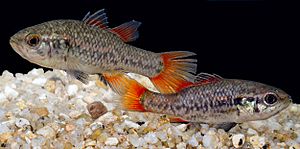Southern pygmy perch facts for kids
Quick facts for kids Southern pygmy perch |
|
|---|---|
 |
|
| Conservation status | |
| Scientific classification | |
| Synonyms | |
|
The southern pygmy perch (Nannoperca australis) is a small freshwater fish. It's also known as the Tasmanian pygmy perch. This fish belongs to a group called ray-finned fish. It lives in rivers and lakes in southeastern Australia and Tasmania.
Contents
Meet the Southern Pygmy Perch
The southern pygmy perch has a body that is a bit flat from side to side. Its back is slightly curved, and its belly is straight. It has a large head with a slightly bulging top and a blunt nose. Its mouth is a little slanted and can stick out. The mouth has thin rows of tiny teeth.
What Does It Look Like?
The color of these fish can change a lot. It depends on where they live. They can be pale cream or even greenish-brown. Their undersides are usually lighter. They might have dark spots or stripes on their sides.
During the breeding season, male southern pygmy perch become much brighter. Their back, anal, and tail fins turn red with black edges. The fins on their belly and the area around their bottom also turn black. These fish can grow up to about 8 centimeters (3 inches) long. However, they are usually around 6 centimeters (2.4 inches) long.
Where Do Pygmy Perch Live?
Southern pygmy perch are only found in temperate river systems in southeastern Australia. You can find them in the Murray-Murrumbidgee river system in New South Wales. They also live in Victoria (Australia) and as far west as Ewens Ponds in South Australia.
They are also found on Flinders Island and King Island in the Bass Strait. In Tasmania, they live in rivers that flow north.
Pygmy Perch Habitat and Diet
Southern pygmy perch live in many different freshwater places. They just need to have lots of water plants. They can be found in still water or slow-moving water. This includes streams, lakes, billabongs (oxbow lakes), ditches, ponds, swamps, and even wetlands that sometimes dry up. In all these places, they prefer to stay in areas with lots of plants along the edges.
What Do They Eat?
This fish is mostly a carnivore, meaning it eats other animals. Its diet mainly includes small invertebrates. These are tiny creatures without backbones. They eat mosquito larvae and other insects. They also munch on Daphnia and other small crustaceans. As they get older, they eat larger insects like mayflies. Because their mouth is small, they don't usually eat other fish.
Pygmy Perch Reproduction and Life Cycle
Southern pygmy perch become ready to have babies in their first year after hatching. Males are ready when they are about 30 millimeters (1.2 inches) long. Females are ready when they are around 33 millimeters (1.3 inches) long.
The breeding season starts in late winter and goes into early spring. This happens when the water temperature rises above 16°C (61°F). Breeding males protect a small area from other males. The female lays small groups of eggs in the water plants or on the riverbed within the male's territory. These eggs hatch into tiny larvae, about 3-4 millimeters (0.12-0.16 inches) long, just 2-4 days after being fertilized.
Protecting the Southern Pygmy Perch
The southern pygmy perch used to be common in New South Wales. But now, it has mostly disappeared from that state. There are only three known places where it can still be found. It is still common in coastal Victoria. However, it is rare in the Murray River area of Victoria. It is also rare and threatened in South Australia. In Tasmania, it is still quite common.
Why Are They Disappearing?
The reasons for their decline include harmful fish that are not native to Australia. These include brown trout, Gambusia (also known as mosquitofish), and European perch. Other problems are habitat fragmentation, which means their living areas are broken up, and habitat destruction.
The IUCN looked at the status of this fish in 2019. They decided it is "Near Threatened". This means it could become threatened in the future. The Department of Primary Industries in New South Wales has started a program to breed these fish in captivity. This helps increase their numbers.
Pygmy Perch in Aquariums
The southern pygmy perch is sometimes kept as a pet in aquariums in Australia. People keep them in cold water tanks or outdoor ponds.


